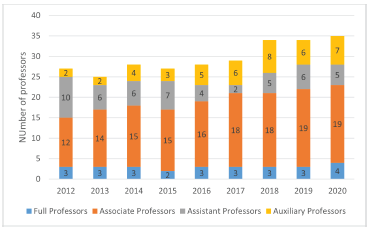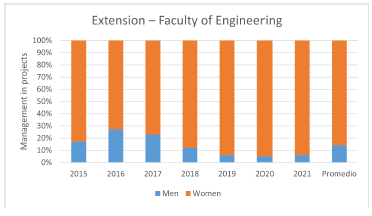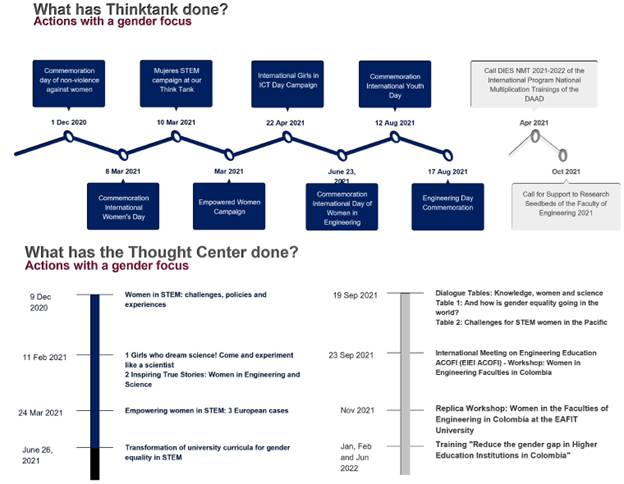Introduction
The Faculty of Engineering of Universidad Nacional de Colombia (UNAL) has a profound and complex history, which is inexorably linked to the last two centuries of Colombia's convulsed history. The origins of the Faculty date back to 1848, with the creation of the Military College, sponsored by General Tomas Cipriano de Mosquera. The political pugnacity that characterized this time had a great impact on the Military College's fate, which was closed in 1854 and thus remained until General Mosquera, once again in power, issued a decree on August 24, 1861, which restored the College and founded the Polytechnic School. This date is recognized by historians as the creation of the Faculty of Engineering, only four decades after the Republic of Colombia gained independence from the rule of the Spanish empire. Therefore, the foundation of the Faculty is considered to be one of the first successful projects of the fledgling Republic to change the state of affairs inherited from colonial times.
Nowadays, the Faculty offers nine undergraduate programs, four specializations, 16 Master's programs, and eight doctoral programs. Thus, it harbors more than 7 5000 students, 278 full professors, 92 administrative employees, and invaluable collaborators. It is thanks to all members of this community that, as of 2023, this is still the most important and representative Faculty of Engineering in Colombia, given its tradition, its prestige, its public nature, the quality of education offered, and the human and professional quality of more than 40 0000 men and women engineers who call themselves alumni.
During the Faculty's first 80 years, sociocultural conditions radically hindered access by both young and adult women as students or professors, so, until the 1930s, this was an all-male Faculty. The story of women in the Faculty only began in 1943, with the admission of the first two women students. Throughout the following eight decades, women have been gaining terrain as students, professors, researchers, and executives. Despite this, the Faculty is still the most masculinized in UNAL (Quintero, 2016).
Several studies have concluded that the absence of women role models is one of the reasons why girls and female teenagers do not choose careers in engineering as life options (Oliveros et al., 2016; Bello, 2020; Olmedo-Torre et al., 2018; Dulce-Salcedo et al., 2022). Thereupon, this article seeks to provide visibility to the historical participation and contribution of women to the Faculty of Engineering's growth and development, acknowledging their contributions by name in order to honor their struggles and victories in support of women's rights in the country.
In recognition of the women that make up the Faculty's current community, this article presents a characterization of the women students, professors, and researchers of the last 10 years, with the aim to evince the immense gender gaps that still remain. Likewise, this work aims to highlight the actions undertaken by the Faculty as policies to foster gender equality.
The objective of this paper is to provide visibility to the drive, leadership, and contributions of women, who have managed to become role models for our academic community and our country, in the construction and development of UNAL's Faculty of Engineering. To this effect, this article is organized as follows. In the section pertaining to students, a brief review is made regarding the history of the presence of women as students in the Faculty; by means of testimonials and statistical figures, historical gender gaps are evidenced, and data types are shown, disaggregated by sex, which are provided by institutional information systems, thus allowing to characterize the current students. In the section dedicated to teachers, a historical review is included which highlights the first women teachers in each Faculty department, showing the figures that evidence the gender gaps in academia, and characterizing the current teachers based on institutional data. The section pertaining to women executives highlights the women who have held leadership and directorship positions in the Faculty. This section shows the figures that evidence the contribution of women teachers as leaders in research and extension projects. The section addressing the gender gaps in the Faculty allows identifying, with the help of figures, the issues that still remain in the Faculty. The last section highlights the measures taken during the last 10 years in the Faculty of Engineering which have been aimed at mitigating the existing gender gaps and proposing future actions. Finally, conclusions are presented.
With this general view of the history of women's participation in the strengthening of the mission functions of the Faculty, we seek to provide visibility, by means of data, to the female population's own nature, showing the role of women in engineering programs and contributing to a documented gender perspective in order to draw lines of future action in the Faculty.
The students
The record regarding the first two women admitted as students in the Faculty dates back to 1943. Their names are Guillermina Uribe Bone and Rosalba Pachon Gomez. Eng. Uribe received her degree as a Civil Engineer on December 18, 1948, being the Faculty's first female graduate (Mayor Mora, 2011).
With the creation of new academic programs, other young women were motivated to attend engineering programs. Some of these programs' women alumni were Maria Stella Miranda Gonzalez, civil engineer, 1967; Alicia Salazar Jaramillo, electrical engineer, 1970; Carmen Aminta Moreno, chemical engineer, 1971; Blanca Cecilia Lopez Rico, electrical engineer, 1973; Fanny Villamizar Copete, agricultural engineer, 1975; María Rozo Mendez, agricultural engineer, 1976; Leticia del Carmen Gil Caraballo, mechanical engineer, 1979; María Constanza Parra Bohorquez, mechanical engineer, 1983; Elvira Elena Polo de la Barrera, systems engineer, 1985; Diana Maria Rojas Ordus, electronics engineer, 2003; Nohora Rodríguez, industrial engineer, 2006; and Jennifer Paola Corredor Goí mez, mechatronics engineer, 2008.
The path paved by these valuable pioneers was not without obstacles. The almost absolute masculinization of the Faculty, in addition to the traditional exclusion of women in these areas (Quintero, 2016) caused situations of discrimination to be normalized for decades. These include those mentioned by engineers Guillermina Uribe Bone during an interview (Mayor Mora, 2011) and Alicia Salazar Jaramillo and Victoria Beatriz Duraí n in the discussions held with the first women alumni, within the framework of the celebration of the Faculty of Engineering's 160th anniversary (FI-UNAL, 2021a).
According to Guillermina Uribe Bone's testimonial (Mayor Mora, 2011, p. 203), "she found most of her teachers very kind and fiendly, but socially distant, as they made her feel that engineering was not for women".
Eng. Salazar (FI-UNAL, 2021a) said: "when the program's actual subjects began, I always found myself alone. I had teachers who found it funny that a woman was studying the program. I also had teachers who told me... The Electrical Machines professor - I won't forget - told me one day that he did not understand why women meddled in the field of men, and I answered: 'because you're a rebel when you're young, and the program doesn't belong to you; it belongs to science'. Of course, I failed Machines. Twice."
On her part, Eng. Duran recounts (FI-UNAL, 2021b): "I always chose the Faculty of Sciences or the Faculty of Engineering to have a cup of coffee because there were women's bathrooms. Meanwhile, in Engineering, they were notoriously absent. (... ) It was terrible because there were men's bathrooms, but it seemed as though women didn't need any bathrooms". This situation continued for decades, as recounted by systems engineer Liz Jeannete Cubillos (2022, personal communication, January 26, 2022): "in the early 80s, in the facilities of the Faculty of Engineering, there were no women's bathrooms. We usually had to go to the Architecture Building. Of course, from Engineering's Old Building, it was wasy to get there, but it was a long way off from the New One. So, given the need, we made groups with the girls at that time, the largest groups were composed of the students of systems and chemical engineering (we were upt to ten per semester), and we talked and said that we needed a bathroom, and that one of the two bathrooms next to the A, B, and C auditoriums of Building 453 should be ours. Then, we decided to seize the bathroom. That meant painting the door pink and hanging signs saying it was a women's bathroom. And we started to go into this bathrooms and tell the cleaning ladies that it was ours. We went to the bathroom in groups after we got out of class, and, if we found a man there, we whistled at him and got him out. So, we started telling all the girls that we should use the bathroom, that it was ours and that we had the right, and so we made it. Within a semester, we managed to appropriate the bathroom, and it became a fact that that bathroom belonged to us women."
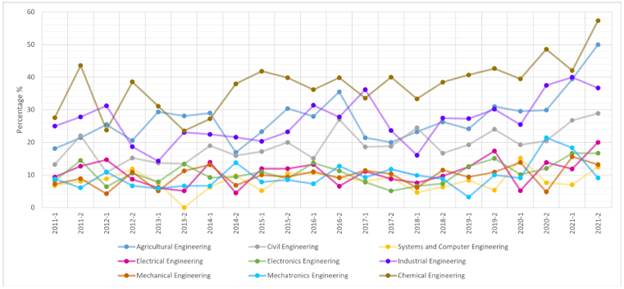
Source: Authors, based on the information recorded in the DNINFOA (2021) reports
Figure 1 Percentage of women admitted to Faculty programs between 2011-1 and 2021-2
As another act of discrimination that has been normalized and therefore socially accepted, until the 1970s, the Faculty of Engineering granted its women graduates the title of ingeniero (engineer, with a masculine ending in Spanish). It was thanks to the lonely battle waged by student Blanca Cecilia Lopez Rico that the title of ingeniera was first granted in 1973. In her case, it was ingeniera electricista (electrical engineer).
Countless battles and conquests such as these are part of the Faculty's history, and it is thanks to these struggles for women's rights that the Faculty of Engineering today holds a place of honor in the history of education and the practice of engineering in Colombia.
As of 2023, the participation gap between men and women in the Faculty is still significant. According to the information provided by the Planning Directorate of UNAL's Bogotaí Campus (UNAL, 2021a), the Faculty has 1 482 women and 5 612 men as active undergraduate students, and 169 women and 472 men as active graduate students. These figures evince participation gap between men and women as students of the Faculty. In the undergraduate programs, only 20,89% of the students are women, and in the graduate programs, this percentage goes down to 26,3% (UNAL, 2021a).
Figure 1 shows the percentage of female students admitted to the programs of the Faculty between the 2011-01 and 2021-02 semesters. In turn, Figure 2 presents the amount of men and women graduated from the Faculty between 20121 and 2021-2. Table 1 shows the average percentage of men and women graduates per program within the analyzed time interval.
Figure 1 identifies two program groups as a function of the percentage of admitted women. With figures higher than 11% are the Civil, Agricultural, Industrial, and Chemical Engineering programs. With percentages lower than 11% are the Electrical, Electronics, Mechanical, Mechatronics, and Systems and Computer Engineering programs.
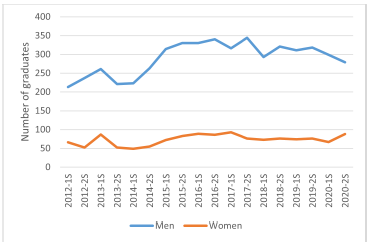
Source: Authors, based on the information recorded in the reports provided by DNINFOA (2021)
Figure 2 Number of graduates by gender between 2012-1 and 2020-2
In Figure 2, it can be seen that the number of women graduates is proportional to the percentage of admitted women. On average, during the analyzed time window, 20% of the undergraduate curricular programs' alumni were women.
Table 1 shows the marked difference between the percentages of men and women graduates. The programs closer to parity are Chemical Engineering and Agricultural Engineering. The greatest inequality is found in the Mechanical, Mechatronics, and Systems and Computer Engineering programs. This behavior follows a similar trend to that of Figure 1, which shows the percentage of admitted women per program.
Table 1: Average percentage between men and women graduated from each program of the Faculty of Engineer between 2012-1 and 2021-2
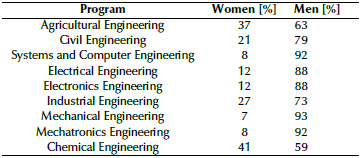
Source: Authors, based on the information recorded in the reports provided by DNINFOA (2021)
Producing relevant information and statistical data disaggregated by sex is fundamental and essential to analyzing the causes of gender inequality (PNUD et al., 2017). As stated by Navi Pillay,a United Nations High Commissioner for Human Rights (2008-2014) (PNUD et al., 2017, p. 19) "more than treasuring what we measure, it is necessary to measure what we measure", which is why this paper highlights the advances made by UNAL in this regard, and it shows some of the statistical data disaggregated by sex that are available in the institutional information systems.
Some average socioeconomic and academic characteristics of the students who have successfully completed their studies are shown in Figures 3a, 3b, 4a, 4b, and 4c.
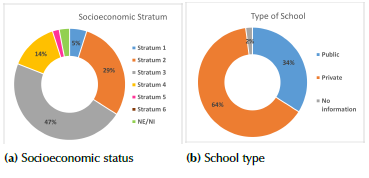
Source: Authors, based on the information recorded in the reports provided by DNINFOA (2021)
Figure 3 Characterization of women alumni between 2012-1 and 2021-2 by (socioeconomic) stratum and school type
Figures 3a and 3b show that, in the analyzed time window, most Faculty alumni belonged to socioeconomic strata 2 and 3 and came from private schools.
Figure 4 shows that most students graduated between 23 and 24 years old. Figures 4b and 4c show that only 8% of the alumni attended the study plan in the expected time (ten semesters), and most students attended their corresponding program in 11-13 semesters and obtained academic averages between 3,8 and 4,1.
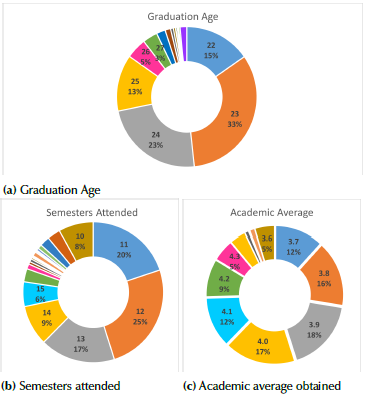
Source: Authors, based on the information recorded in the reports provided by DNINFOA (2021)
Figure 4 Characterization of women alumni between 2012-1 and 2021-2 by age, semesters attended, and academic average
The professors
The incursion of women as teachers of the Faculty of Engineering started at the end of the 60s, with the employment of chemical engineer Elena Pineda Gutierrez (1969). As the program offering grew in the Faculty, and with different dynamivs in each department, the employment of women teachers increased. Some of the first teachers attached to the different departments and programs were Fanny Villamizar, who joined the Agricultural Engineering program in 1977; Estrella Esperanza Parra Lopez, linked to the Electrical Engineering program since 1980; Victoria Beatriz Duran (1975) and Luz Amanda Salazar (1979), linked to the Civil Engineering program; Dolly Santos Barbosa and Angela Quintero, linked to the Chemical Engineering program since 1990; and María Alejandra Guzman Pardo, linked to the Mechanical Engineering program since 1997.
The total number of professors attached to the Faculty has remained constant in the last decade. Currently, outr of the 278 full-professors, 35 are women. Figure 5 shows the amount of women teachers attached to the Faculty, disaggregated by category, between 2012 and 2020. Even though the data show a moderate increase in the percentage of Faculty women teachers, going from 8,9 to 12,5%, the employment gap between men and women is still very wide.
As for the schooling level, according to the information provided by the Bogota Campus Planning Directorate of UNAL (2021a), 77,1% of the Faculty's women professors have a PhD degree - the average percentage of Bogotá Campus teachers with a PhD is 52,15%, and that of the Faculty of Engineering is 57,64%.
Women executives
Women teachers have contributed to the planning, development, and governance of the University and the Faculty, serving as executives in academic-administrative positions.
Table 2: Women teachers of the Faculty in academic-administrative positions between 2012-1 and 2021-2
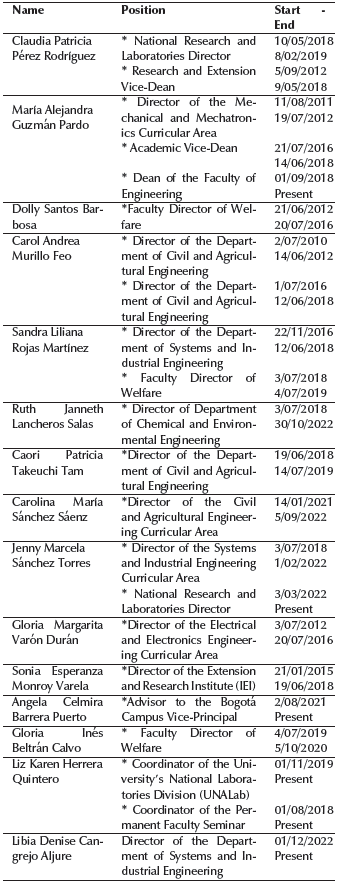
Source: Authors, based on the information of DNINFOA (2022a)
In its 161 years of history, three women have occupied the Dean's office, the highest management position of the Faculty. They are:
Victoria Beatriz Duran Betancourt, civil engineer, who graduated in 1975 from UNAL's Faculty of Mines, Medellín Campus. Her term as dean started in 1990 and ended in 1994.
Luz Amanda Salazar Hurtado, civil engineer, who graduated in 1972 from UNAL's Faculty of Engineering and Architecture, Manizales campus. Her term as dean started in 2000 and ended in 2002.
María Alejandra Guzman Pardo, mechanical engineer, who graduated in 1996 from UNAL's Faculty of Engineering, Bogotá Campus. Her term as dean started in 2018, and she is still in office.
Other women professors who have stood out in management positions in the last ten years are shown in Table 2.
As seen in Table 2, in the last ten years, 15 women professors have occupied management positions in the Faculty and the University, i.e., 42,85% of women professors have participated in the construction and execution of the Faculty's action plans, as well as in its governance, assuming leadership roles.
Women leaders in research and extension projects
Next, this section analyzes women participation in research and extension by women in the Faculty of Engineering during the last ten years.
As for research work in the Faculty of Engineering, there is progress in the number of female professors leading projects between 2005 and 2020, with a significant increase specifically during 2019-2020 (Figure 6).
Figure 7 shows a classification of female professors of the Faculty according to the last three Minciencias calls. A rise in rank is observed for female professors (from associate researcher to senior researcher), which is an indicator of the increased academic and research productivity of women in the Faculty of Engineering.

Source: Authors, based on the information of the HORUS system (UNAL, 2021b)
Figure 6 Research project directors, 2005-2020
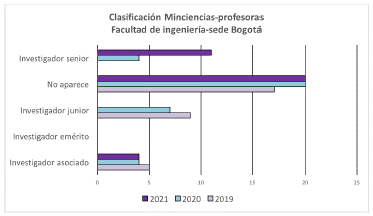
Source: Authors, based on the information of the Research and Extension Vice-Principalship of UNAL's Faculty of Engineering
Figure 7 Female researcher classification for UNAL's Faculty of Engineering
As for the participation of female professors in extension, Figure 8 shows the percentage of professors who led or took part in teams developing extension projects. Avery low participation by female professors in this regard is evidences.
Gender gaps in the Faculty of Engineering
A gender gap is a measurement of the distance between men and women with regard to an indicator. In the previous sections, it has been evinced that the number of male students in the Faculty is four times higher than that of women. Female professors represent only 12,5% of the Faculty's full-professors. Similar percentages are found when analyzing the participation of women as directors of research and extension projects, as well as in high administrative offices. All of the above demonstrate the existence of gender gaps in the Faculty of Engineering..
This situation is far from being exclusive to UNAL's Faculty of Engineering. Around the world, the gaps in the STEM areas (science, technology, engineering, and mathematics) are remarkable. According to UNESCO (2019), during the 2014-2016 period, at a global level, the average participation of men, specifically in fields such as information and communication technologies and engineering, manufacturing, and construction, significantly surpasses that of women (Figure 9).
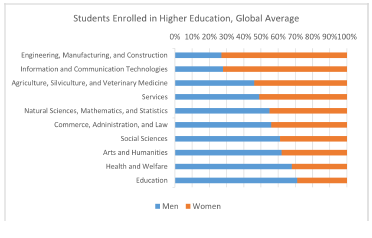
Source: Authors, based on data from UNESCO (2019)
Figure 9 World average of student participation in higher education by sex and field
Figure 9 shows that, in the fields of engineering, technology, and construction, 27% of students are women; in the case of information and communication technologies, 28% are women. According to the data published by UNESCO's Statistics Institute (Bello, 2020), as of 2019, the percentage of women researchers was 29,3%, and only 3% of the Science Nobel Prizes had been awarded to women.
In light of a situation taking place all around the world, why should the gender gaps in the field of engineering and in UNAL's Faculty of Engineering be addressed?
As stated by María Noel Vaeza (UNESCO, 2019, p. 7), "It is often said that professional careers in STEM are the jobs of the future, in order to foster sustainable development; these are not only useful to boost innovation, but also social welfare and inclusive growth. According to data of UNESCO's Statistics Institute, a person working in STEM earns two thirds more than people employed in other fields. Despite their relevance, women have been persistently under-represented in several STEM fields.
Providing women with equal opportunities to develop and thrive in STEM careers helps to reduce the gender wage gap, improves women's economic safety, guarantees a diverse and talented workforce, and prevents biases in these fields and in the products and services elaborated within them."
In our country, despite the advances made in recent decades, closing the gender gaps in engineering faculties is still not regarded as a priority, as shown by the results of the Colombian Engineering Departments Association's Survey on the Perception of Services (ACOFI, 2021), where 120 deans and 29 officers of Colombian Faculties of Engineering took part. According to this survey, promoting women's access to engineering programs ranks seventh in the list of priorities, below issues such as curriculum and pedagogy analysis, the use of digital technologies, teaching staff qualification, access by vulnerable populations, and student mobility.
What has been done in the Faculty?
Although there have been important sociocultural changes in Colombia and the world since 1943, when the first two women were admitted as students of the Faculty, there is still much to be done. The Faculty is still deeply masculinized, and it is still a long way off from parity.
Gender equality as an institutional concern from the Faculty's management was evidenced in professor José Ismael Pena's deanship (2012-2018). During the three terms of his administration, the Academic Vice-Deanship, the Research and Extension Vice-Deanship, the management of the Extension and Research Institute, the Welfare Directorate, and the management of the Department of Civil and Agricultural Engineering were led by women in different terms, all of them representing leader female voices and with a capability to make decisions in the Faculty Council. Another initiative was the creation of the video series Andrea y la ingeniería (Andrea and Engineering), which are available on Youtube and are aimed at Colombian girls and female teenagers, in order for them to recognize engineering careers as an opportunity for professional and personal development (FI-UNAL, 2015). On the other hand, the radio show Ingeniería y nación (Engineering and Nation) was created, which is transmitted weekly via UN Radio and has dedicated many broadcasts to providing visibility to the women in the Faculty.
Starting in 2018, closing the gender gaps has been a priority for the Faculty's management. For the first time since it was created, the management of the Department of Chemical and Environmental Engineering would be led by a woman, professor Ruth Janeth Lancheros Salas. Profs. Sandra Liliana Rojas Martínez and Gloria Inés Beltran Calvo have been Directors of Welfate in the Faculty, and professors Carolina María Sanchez and Marcela Sanchez Torres have been at the forefront of the Civil and Agricultural Engineering and the Systems and Industrial Engineering Curricular Areas, respectively. Prof. Liz Karen Herrera is the coordinator of the Permanent Faculty Seminar, and professor Libia Denis Cangrejo is the director of the Department of Systems and Industrial Engineering.
During 2019, with the collaboration of female experts in gender issues attached to the WICA organization (Women in Concrete), workshops were conducted with Faculty professors on gender equality, while also aiming to disseminate the Protocolo para la prevention y atencion de casos de violencias basadas en giénero y violencias sexuales (Protocol for the prevention and attention of cases involving gender and sexual violence) (UNAL, 2017), with the participation of 110 professors.
Between 2018 and 2020, and up until there were face-to-face classes on the campus, which were interrupted by the COVID-19 pandemic, in the digital billboards distributed in Faculty spaces, campaigns were permanently disseminated which were related with gender equality and non-violence against women.
In 2020, in collaboration with executives, men and women professors, and students of UNAL's Faculty of Engineering, Faculty of Mines, and Tumaco Campus, and with the support of the Research and Extension Vice-Principalship, the Thinktank for the Strengthening of Leadership and Empowerment of Colombian Women in STEM Areas (CPMC), managed by the Dean of theFaculty of Engineering.
Figure 10 summarizes some of the actions undertaken by the Thinktank, which has managed to visibilize and implement actions with a gender focus in the Bogotaí Campus, the Medellíín Campus, and the Tumaco Campus. UNAL's thinktanks are associations of researchers from diverse areas of knowledge and social actors, who, via research, academic debate, the production of documents, and the interaction with strategic sectors and problems of the national reality, define and influence, upon the basis of their networking, the evaluation and formulation of public policies (UNAL, 2022b). The objective of this Thinktank is to strengthen leadership and empower Colombian women in the areas of science, technology, engineering, and mathematics, by means of spaces for discussion and research aimed at designing roadmaps that allow to articulate initiatives and develop public policies at the regional and national levels, empowering women in education and science.
In 2019, as an initiative of the Faculty of Engineering, which was led by professor Elizabeth Leon Guzman, the Prototype Business Intelligence System for Monitoring the Scientific and Technological Capabilities of Universidad Nacional de Colombia (HORUS) (UNAL, 2021b). The objective of the HORUS system is to integrate and visualize the information on scientific and technological productivity generated by the teachers of UNAL's Faculty of Engineering, contributing to an improved national and international visibility, which allows generating strategic alliances and supporting decision-making. HORUS allows obtaining information disaggregated by sex, providing data that support the measurement of indicators with a gender focus. This prototype of the Faculty has been endorsed for an institution-wide scaling.
Starting in November 2021, as part of the action plan outlined by the Faculty's Welfare Directorate, a professional psychologist with experience in gender issues was added to the team, in order for her to support the elaboration of a strategy for fostering equity, gender equality, and women empowerment, as well as the promotion of new masculinities in the Faculty's community.
From the management of the Faculty of Engineering, with the accompaniment provided by a female professional expert in gender issues, the main axes of the strategy Equidad con ingenio (Equity with wit) have been designed. This strategy will be implemented during 2022-2023 and will set the foundations of what will be applied until 2025. The axes of this strategy are: violence and equity, women empowerment in STEM, and research on gender-based partner violence. This strategy includes workshops and awareness and alphabetization campaigns, as well as addressing issues such as new masculinities, the prevention of gender violence, and the promotion of active femininities, among others.
Measuring and visibilizing to advance
We evidenced a need to continue working on gender equality policies in UNAL anf the Faculty. The general behavior of the Faculty indicates a low proportion of women at each level, which does not exceed a 21% participation.
This analysis provides visibility to the data in order to identify gender gaps, and, as a function of the results, it indicates the need to favor effective equality in the Faculty of Engineering, by means of gender strategies implemented by the Research and Extension and Academic Vice-Principalships, as well as by the Faculty's Welfare Directorate, which allow acting and making progress in contributing to equality policies for higher education institutions in Colombia.
In general terms, gender data collection must be strengthened in the Faculty and the University. Statistics show a gradual increase in women participation as teachers in the Faculty of Engineering, going from 8,9 to 12,7%. As for research work in the Faculty of Engineering, there is progress in the presence of female project directors, with a quite significant increase specifically for 2019, 2020, and 2021. The presence of women in extension projects should continue to be strengthened, as a low participation is evidenced regarding female project leaders or women in the teacher teams of extension projects. The data show that, at a general level, in the last three Minciencias calls, there is a significant number of female professors from the Faculty who are not classified as researchers, which is why the participation of women teachers-researchers in these calls must be encouraged. On the other hand, it is evidenced that associate researchers have been promoted to senior researchers, which implies an increase in academic and research productivity by the women at the Faculty of Engineering.
Challenges, actions, and recommendations
As a function of the data reported in this paper, strategies must be proposed in order to encourage the participation of more female teachers in research and extension. It is also important to highlight that, in recent years, there has been an improvement in the presence of women in management roles at the Faculty. On the other hand, the Faculty of Engineering has proposed some recommendations and actions, such as generating internal policies to strengthen the Faculty's gender perspective, to encourage academic networks led by graduate and undergraduate students with equal involvement, to encourage gender-focused research and extension projects within the Faculty, to continue fostering the participation of Faculty female teachers in management-level positions, and to continue participating in STEM networks in higher education institutions and government and private entities, with the aim to promote the strengthening of women in Colombia.
Conclusions
Women's participation in the construction and development of UNAL's Faculty of Engineering started with the admission of the first two female students in 1943. Since then, the contributions made by women to the growth and positioning of the Faculty have been conrinuous and significant. Giving visibility to the women at the Faculty is an important step to achieve the recognition they deserve.
As forthetestimonials and statistical figures presented in this article, it can be inferred that it is necessary to visibilize the existence of gender gaps in engineering areas (particularly in the Faculty), as well as to raise the awareness many actors in all levels regarding what gender gaps are, why they must be tackled, and which actions contribute to closing them.
The under-representation of women in engineering areas around the world, in Colombia, and in the Faculty is an issue with a high social impact which must be acknowledged and addressed by the actors involved. Therefore, it is necessary to insist on the development of strategies allowing Colombian girls and female teenagers to see engineering as feasible options while choosing a professional career in which they can also achieve the personal and professional fulfillment that they desire.
As for women professors and researchers, we evidenced the need to permanently visibilize the work and contributions made by women in teaching and research processes. In this sense, it is important to advance initiatives such as the HORUS system, which, for the first time, has allowed collecting research and extension data discriminated by gender, employing a data analysis strategy that gives visibility to the work carried out by men and women teachers of the Faculty in a dynamical and continuous way.
With regard to leadership positions, the figures show a high interest by female professors at the Faculty in occupying academic administration positions with decision power. Visibilizing this fact not only acknowledges their commitment; it is also a motive for other female professors to engage in leadership roles.














